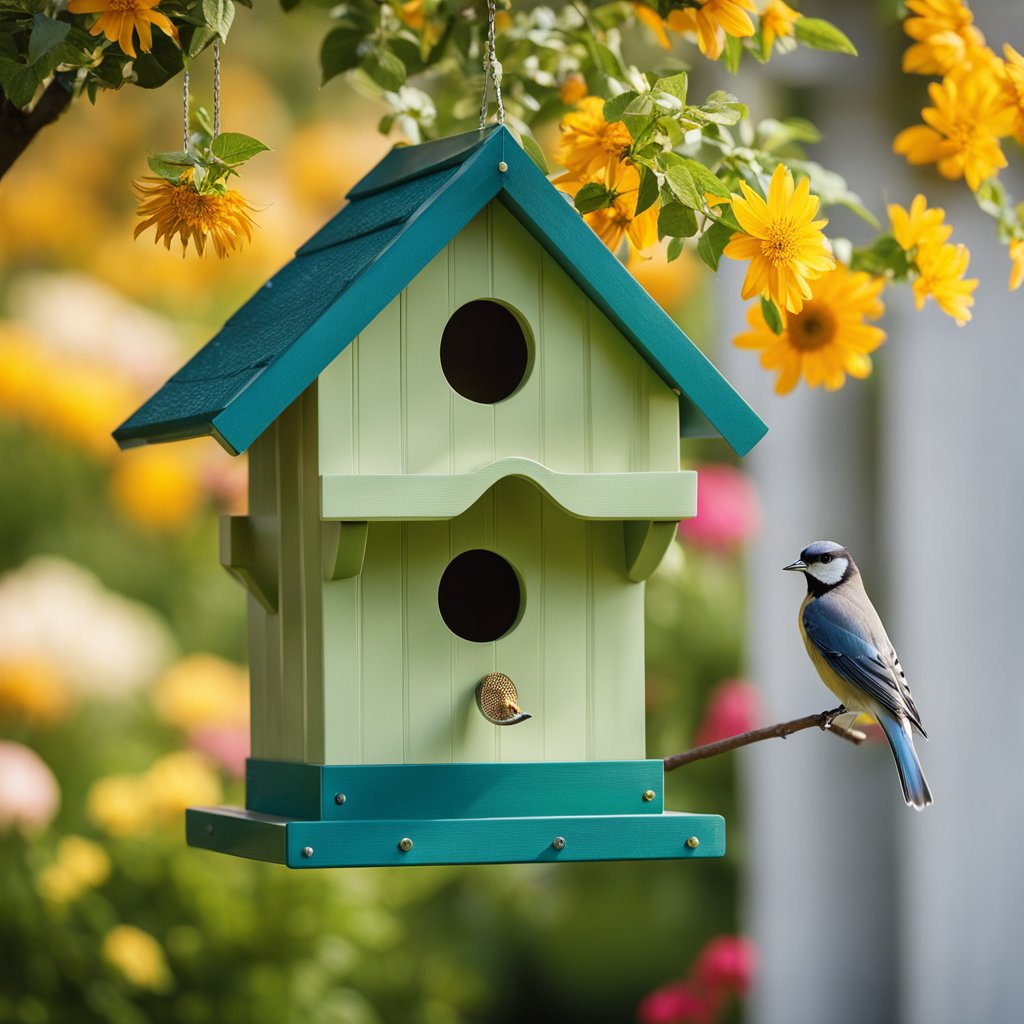Providing birdhouses is an excellent way to attract beautiful, fascinating birds to your yard or garden. Installing proper housing for birds helps support local bird populations and enhances biodiversity. Watching colorful songbirds visit your birdhouses to nest and raise young provides an enjoyable connection to nature right outside your window.
Attracting birds to nest in your yard has many benefits beyond aesthetic enjoyment. Birds provide free natural pest control by preying on insects and other garden pests. Songbirds will eat mosquitoes, ticks, caterpillars, beetles, grubs, and other annoying bugs.
Birds also scatter seeds from plants and trees, assisting your garden’s pollination and growth. The beautiful colors, motions, and songs of visiting birds create a lovely backdrop as you enjoy your garden. You’re also helping conserve avian populations by creating a safe nesting habitat.
Understanding Bird Preferences
Bird Species and Their Habitat Needs
There are many species of birds that may visit your yard, depending on your location. It’s important to research which birds are native to your area and what their preferred nesting habitats and foods are.
For example, bluebirds prefer open fields and meadows, while chickadees like deciduous woods and thickets. Sparrows and wrens favor shrubs and dense hedges, while swallows and phoebes nest in sheltered nooks on buildings. Understanding bird species’ preferences will allow you to tailor your birdhouse setup to best attract specific species.
The Significance of Location for Birdhouses
Where you place birdhouses is extremely important, as birds have specialized nesting preferences. Most birds favor elevated locations with some natural protection from predators and rain. Bird species common to backyards, like chickadees and nuthatches, like to nest 4-15 feet high in mature trees. Bluebirds, phoebes, and swallows nest up to 30 feet high on poles, fence posts, or buildings. Consider the surroundings carefully when positioning birdhouses.
Designing the Ideal Birdhouse
Suitable Materials for Birdhouse Construction
Birdhouses can be made from many materials, but wood and recycled plastic are best. Cedar and redwood are naturally rot-resistant soft woods ideal for birdhouse construction. Pine and fir will suffice if first treated with water sealant.
Metal or ceramic houses may overheat or be too cold. Ensure no lead-based paint, zinc, or galvanized parts contact food. Ventilation and drainage holes must be incorporated into the design.
Optimal Birdhouse Dimensions for Different Species
It’s vital to build or buy a birdhouse sized for your target bird species. The diameter of the entrance hole regulates which birds can enter. Bluebirds need 1.5 inch holes while chickadees require only a 1 inch opening.
Floor dimensions depend on the species as well. Chickadees want a 4 by 4 floor while swallows need 6 by 6 inches. The best birdhouses have a sloping roof of at least 3 inches to allow rain runoff.
Ventilation and Drainage Features
Proper airflow and drainage prevents moisture buildup, overheating, and growth of harmful mold in occupied birdhouses. All birdhouses need ventilation holes near the roof as well as drainage holes in the floor.
Increase ventilation by boring holes on opposite sides of the house or by constructing spaces between roof planks. Ensure the drainage holes are sufficient to allow water to fully drain from the floor.
Choosing the Perfect Location
Height and Orientation Considerations
Mount birdhouses 4 to 15 feet high depending on the target species. Chickadees and titmice like them around 5 feet up while tree swallows want 10-15 foot heights. Face the birdhouse opening away from prevailing winds but provide a drainage gap behind.
Most birds prefer north or east-facing entrances to avoid overheating from southern sun exposure. Elevate houses on metal poles or suspend them from branches to deter predators.
Protection from Predators and Elements
Situate birdhouses out of reach from predators. Cats can jump 5 feet high so elevate houses higher. Raccoons and snakes can climb so placing houses over water or baffles helps. Guard from household pets, too. Ensure a protective overhang shields the entry from direct rain. Turning the hole sideways deters driving wind and rain entering the hole.
Proximity to Food Sources and Water
Put birdhouses within 100 feet of mature trees and shrubs that provide food, shelter, and nesting material sources. Locate them near backyard feeders and fruiting plants. Add a fresh water source like a fountain, mister, or bird bath. Birds favor nesting spots central to critical resources.
Attracting Birds with Proper Nesting Materials
Safe and Desirable Nesting Materials
Providing suitable nesting materials will entice birds to take up residence. Most species seek soft natural fibers, mosses, dried grasses, coconut fibers, hair and string to build nests. Avoid dyed or synthetic fibers. Supply 3-6 inches of wood shavings in the bottom of birdhouses as starter material. Let birds refine the nesting base with found additions for themselves.
Materials to Avoid
Certain man-made materials could harm baby birds in the nest. Avoid polyester and nylon fibers, dryer lint, yarn, plastic, cellophane, metallic ribbon, feathers, and sponge rubber. These may tangle around and cut off circulation to growing chicks. Stick to plain organic fibers. Also, don’t use pesticides around birdhouses; birds are highly sensitive.
Feeding: Encouraging Avian Visitors
Types of Bird Feed Suitable for Various Species
Offering enticing feed will convince birds to visit while also providing needed nutrition. Black-oil sunflower seeds attract the widest range of birds. Nyjer thistle seed draws finches, sparrows, and doves. Suet supplements insect protein needs. Peanut bits appeal to woodpeckers, chickadees, titmice, and jays. Different feeders cater to different species as well.
Feeder Placement and Maintenance
Locate feeders within view of windows for enjoyment but 10 feet from houses to deter rodents. Distribute feeder types to serve various birds – platform, tube, suet cage and hoppers. Use squirrel baffles to protect seed. Clean feeders with diluted bleach monthly to prevent disease transmission. Rake and dispose of old seed under feeders to limit pests.
Understanding Seasonal Feeding Preferences
As seasons change, birds switch food preferences and needs. Offer more suet and high energy sunflower seeds in winter. Provide more fruit, live mealworms, and nectar foods in spring and summer for babies. Cater to migrating birds with seasonal favorites too. Know what birds crave during each season in your area.
Garden Strategies to Attract More Birds
Plant Selection for a Bird-Friendly Habitat
Choosing bird-favorite native plants will draw more birds to nest, roost and eat in your yard. Berry producing shrubs like elderberry, bayberry, holly and sumac provide food sources. Mature conifers supply shelter and nesting sites. Milkweed, coreopsis, and other nectar flowers support hummingbirds and orioles. Select a diverse native plant mix to create an enticing bird habitat.
Creating Natural Shelter and Perches
Incorporate elements that allow birds to feel protected and comfortable. Leave some dead trees, dense shrubs and brush piles as shelter sites. Cluster plantings together to create calming cover. Add branches, posts, trellises and fences as perching spots to survey the landscape. A birdbath or fountain provides drinking and bathing opportunities. Meet birds’ core habitat needs.
The Role of Water Features in Attracting Birds
Adding a water feature will significantly increase backyard birds. Birdbaths, fountains, misters, drippers and small ponds attract a range of species. Ensure fresh clean water, a shallow sloped edge for wading, and proximity to protective shrubs. Move water features around yards to prevent disease transmission. In winter, provide heated basins to give birds a vital open water source.
Ongoing Birdhouse Care and Monitoring
Cleaning and Maintenance of the Birdhouse
Check birdhouses at least annually and clean when birds fledge in fall. Gently scrub with a diluted vinegar and water solution and low pressure hose. Remove old nests, feathers and droppings. Make any needed structural repairs. Apply fresh water sealant if needed to preserve the wood. Perform maintenance when no birds are actively nesting to avoid stress or abandonment.
Monitoring for Activity and Preventing Common Problems
Observe birdhouses frequently from a distance to monitor activity. Ensure other birds or insects haven’t usurped the nest box. Discourage house sparrows and European starlings from taking over boxes by removing their nesting material – they are aggressive species that outcompete native birds. Prevent wasp nests from developing by applying a natural repellent spray inside empty houses. If activity declines, evaluate the location and design to improve its appeal to birds. Enjoy observing the fascinating process of birds building nests, laying eggs, raising young, and fledging from your birdhouses.
People Also Read:
Conclusion
Attracting lively birds to your yard through offering birdhouses and feeders provides a simple pleasure and a fun hobby. Observing their beauty and interesting behaviors creates a mood elevating daily diversion. Listening to their cheerful chatter and song lightens your perspective. Interacting with them by providing habitat and food helps you feel connected to nature’s cycles. Enjoying our fine feathered friends through birdwatching activities is easy, calming, and rewarding.
Providing birdhouses helps counter habitat loss issues that trouble many bird populations. Setting up properly designed nest boxes, food sources, water, shelter, and bird-friendly landscaping fulfills critical needs for breeding birds. Our actions support biodiversity and environmental health. Saving open space, reducing threats, and creating new protected areas aid declining species. We can all contribute through small conservation efforts at home. Supporting birds provides uplifting hope for protecting nature’s web of life.
Frequently Asked Questions
Q: What is the ideal birdhouse height?
A: Mount birdhouses between 4 to 15 feet high depending on the species. Chickadees like around 5 feet. Tree swallows prefer 10-15 feet up. Adjust the height based on the target bird.
Q: How often should you clean out birdhouses?
A: Clean out birdhouses at least once per year after baby birds have fledged, typically in late summer or fall. Wear gloves and a mask to prevent disease transmission when cleaning.
Q: What food will attract the most birds?
A: Black oil sunflower seeds appeal to the widest range of bird species. Also provide suet for insect-eating birds and thistle for finches. Cater to seasonal needs as well.
Q: How can I stop squirrels from stealing all the bird food?
A: Use squirrel-proof bird feeders with weight or bar mechanisms. You can also install plastic or metal baffles on poles below feeders that squirrels cannot pass.
Q: What are the best plants for attracting birds?
A: Native berry bushes, flowering plants, and sheltered conifers or dense shrubs. Milkweed, elderberry, holly, sunflowers, and sumac are excellent choices. Select a diverse range of plants to appeal to many species.

